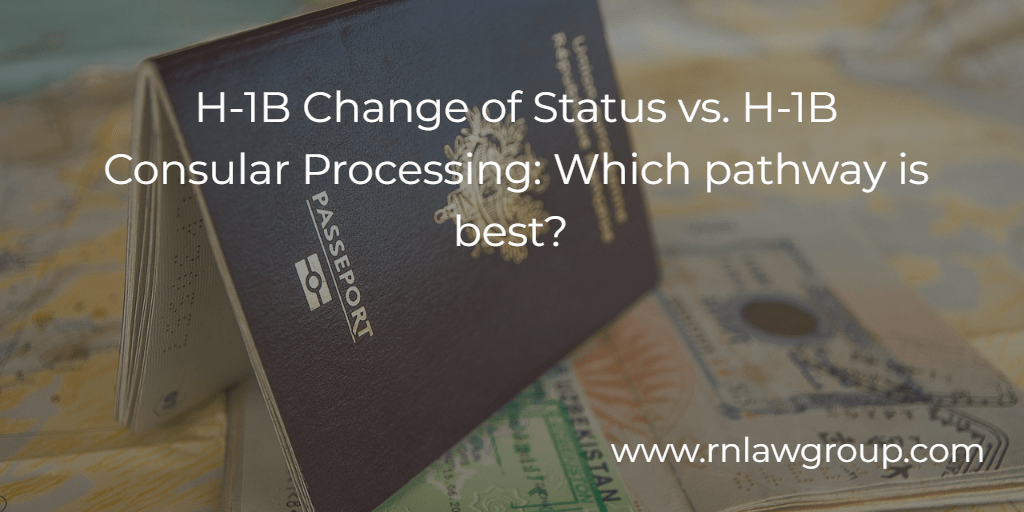
H-1B Change of Status vs. H-1B Consular Processing: Which pathway is best?
The H-1B visa program is one of the most sought-after nonimmigrant visa categories in the United States. It allows U.S. companies to employ foreign workers in specialty occupations that require theoretical or technical expertise. When applying for an H-1B visa, foreign nationals have two primary pathways: Change of Status (COS) and Consular Processing (CP). Understanding the nuances between these two processes is crucial for employers and employees to make informed decisions.
Change of Status to H-1B
Definition: Change of Status (COS) refers to the process where an individual already in the United States on a different nonimmigrant visa changes their visa status to H-1B without leaving the country. This is done through a petition filed with the U.S. Citizenship and Immigration Services (USCIS).
Eligibility:
- The applicant must be in the United States under a valid nonimmigrant status (e.g., F-1, L-1, TN).
- The applicant’s current status must remain valid up to the start date of the H-1B status.
Process:
- Employer Petition: The employer files Form I-129, Petition for a Nonimmigrant Worker, with USCIS on behalf of the employee.
- USCIS Approval: Once the petition is approved, USCIS issues an approval notice (Form I-797), which indicates the change of status effective from the start date mentioned in the petition.
- Status Activation: The applicant’s status automatically changes to H-1B on the start date without the need to leave the United States.
Advantages:
- Continuity: The employee can continue working without interruption if they were already working under a different nonimmigrant status.
- Convenience: No need for international travel, thus avoiding potential delays and complications at United States consulates.
Disadvantages:
- Travel Restrictions: The individual can travel internationally, but they must obtain an H-1B visa stamp from a United States consulate before they can return to the United States. Traveling back to the United States without obtaining this visa could result in complications or denial of re-entry.
- Status Limitations: If the change of status is not approved by the desired start date, the individual may face a gap in work authorization.
H-1B Consular Processing
Definition: H-1B Consular Processing involves the individual applying for an H-1B visa at a United States consulate abroad after USCIS approves the employer’s petition. This process requires the applicant to leave the United States and re-enter with the H-1B visa.
Eligibility:
- Typically used by individuals outside the United States or those whose current visa status cannot be converted to H-1B status within the United States.
Process:
- Employer Petition: Similar to COS, the employer files Form I-129 with USCIS.
- USCIS Approval: Upon approval, USCIS sends an approval notice to the employer and notifies the U.S. consulate chosen by the applicant.
- Visa Application: The applicant schedules an appointment at the United States consulate, completes Form DS-160, and attends the visa interview.
- Visa Issuance: If approved, the consulate issues an H-1B visa stamp in the applicant’s passport.
- Entry to U.S.: The individual can then enter the United States in H-1B status on or after the start date mentioned in the petition.
Advantages:
- Flexibility in Travel: The individual can travel freely once the H-1B visa stamp is obtained.
- Pre-approved Visa: The applicant enters the United States with an H-1B visa already in their passport, reducing uncertainty.
Disadvantages:
- Travel Requirement: Requires international travel, which can be burdensome and may involve delays due to visa appointment availability or processing times.
- Risk of Denial: There is a risk of visa denial at the consulate, which could leave the applicant stranded outside the United States.
Key Differences and Considerations
- Application Location:
- COS: Entirely within the United States.
- CP: Requires travel to a United States consulate abroad.
- Travel Implications:
- COS: Restricted travel until H-1B visa stamping.
- CP: Can travel freely after obtaining the visa stamp.
- Timeline and Processing:
- COS: Generally more straightforward and faster as it does not involve consular appointments.
- CP: May face delays due to consular backlogs or lengthy appointment wait times.
- Risk Factors:
- COS: Lower risk as it involves only USCIS adjudication.
- CP: Higher risk due to additional scrutiny at consular interviews and the potential for visa denials.
- Employment Continuity:
- COS: Allows for a seamless transition and continuous employment if approved timely.
- CP: May involve a break in employment if international travel is required before the visa interview.
Conclusion:
Choosing between H-1B Change of Status (COS) and H-1B Consular Processing (CP) depends on individual circumstances, including current location, urgency, and travel preferences. COS is generally preferred for those already in the United States on a valid nonimmigrant status due to its convenience and continuity, as it allows for a seamless transition without the need to leave the country. This option minimizes disruption to daily life and employment, making it an attractive choice for many.
On the other hand, CP is suitable for those outside the United States or ineligible for COS. This route involves obtaining the H-1B visa stamp at a U.S. consulate abroad before entering the country. While it may require additional travel and planning, CP can be beneficial for individuals who are currently overseas or those who need to leave the United States for personal or professional reasons.
Both pathways have their advantages and potential challenges. COS may be faster and more convenient, but it can be limited by strict eligibility criteria and the current immigration status of the applicant. CP, although requiring a consular interview and potentially longer processing times, can offer more flexibility for those not already in the U.S. Understanding these differences is essential for a smooth transition to H-1B status.
To discuss these processes effectively, consulting with immigration professionals is highly recommended. They can provide personalized advice based on individual circumstances, ensuring compliance with immigration laws and regulations, and helping to avoid common pitfalls. Making an informed decision between COS and CP can significantly impact the ease and success of obtaining H-1B status, aligning with both personal and professional goals.
By: Felipe Jimenez
Felipe Jimenez is an Associate Attorney at Reddy & Neumann, P.C. He works in the Non-Immigrant Visa (NIV) Department where he assists clients through all phases of the non-immigrant visa process.
Reddy & Neumann, P.C. has been serving the business community for over 20 years and is Houston’s largest immigration law firm focused solely on US. Employment-based immigration. We work with both employers and their employees, helping them navigate the immigration process quickly and cost-effectively.

